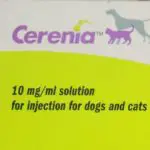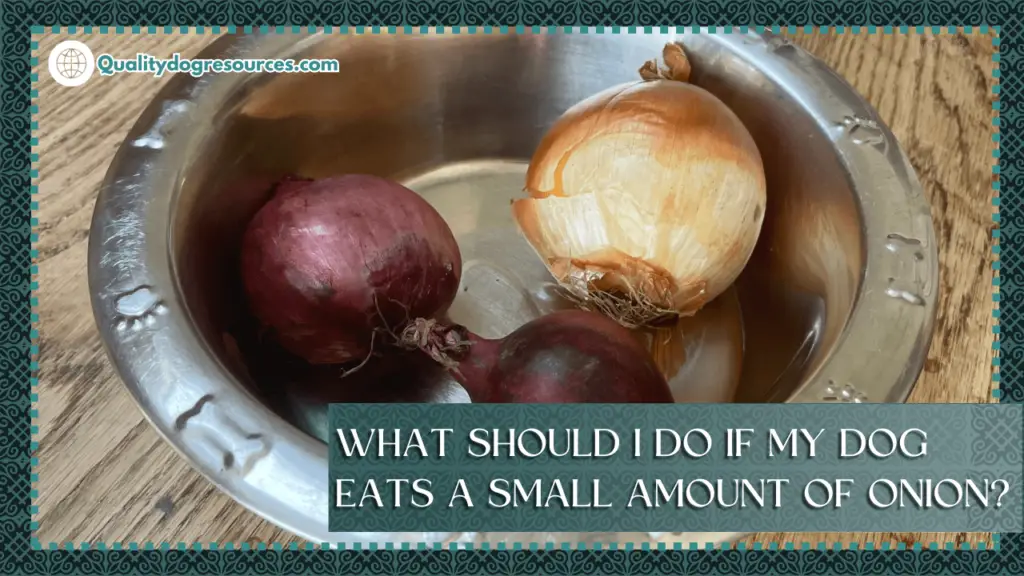
If your dog eats a small amount of onion there is a chance that your dog won’t get ill. However, there is also a chance that your dog might become seriously ill. Onions contain a sulphuric compound that makes them very toxic to dogs and can be fatal. To work out if your dog has eaten enough onions to poison them, you will need to know the weight of your dog and how much onion they ate.
You will also need to be vigilant for any signs of onion poisoning- the main one is lethargy or weakness. Don’t expect to see symptoms of onion poisoning immediately after your dog has eaten the onion, it can take a few days before you see any obvious symptoms of poisoning. If your dog has been poisoned, then there are different ways that your local veterinarian can treat them. One of the main approaches is to induce vomiting. Unfortunately trying to treat a dog that has eaten too many onions isn’t possible at home- your dog will need to be taken to your local animal hospital. And finally, all types and varieties of onions are highly toxic and raw onions are as dangerous as cooked onions. Any other vegetable in the onion family is also highly toxic to dogs.
Table of Contents
- Why are onions toxic to dogs?
- How much onion will kill a dog?
- What are the signs of onion toxicity in dogs?
- How long does it take for onions to poison a dog?
- Four ways that vets treat dogs with onion poisoning
- Can dogs with onion poisoning be treated at home?
- What types of onions are toxic to dogs?
- Can dogs eat the other vegetables that are members of the onion family?
Why are onions toxic to dogs?
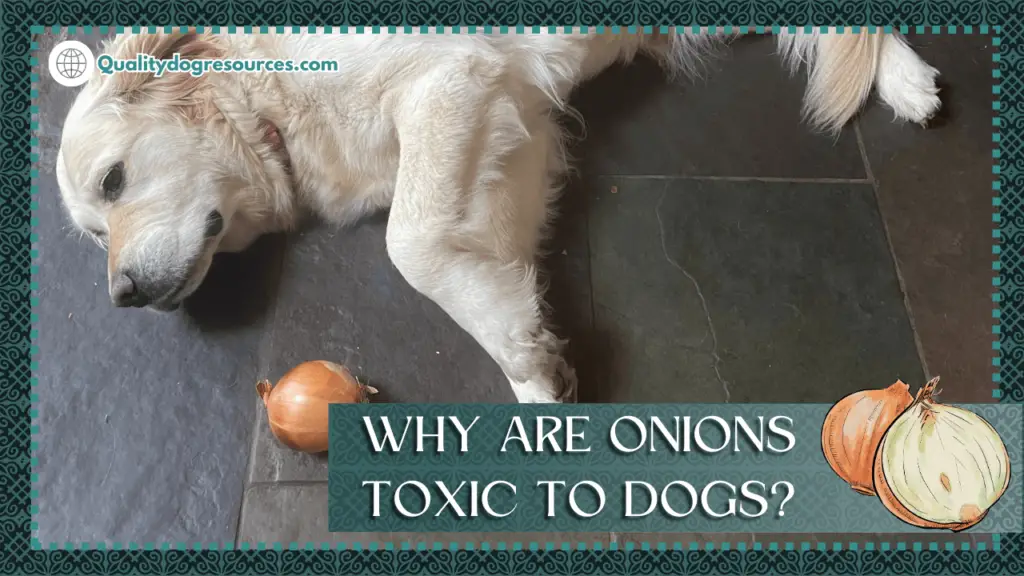
Onions are toxic to dogs because of a sulphuric compound called n-propyl disulphide.
Whereas this compound isn’t toxic for humans (because our bodies can absorb it) it is toxic to dogs because their bodies cannot absorb it properly.
Instead of being absorbed, the n-propyl disulphide attaches itself to the oxygen molecule in the red blood cells and attacks the protein haemoglobin. Red blood cells are important to a dog because they carry oxygen to all parts of its body and it is the haemoglobin that releases the oxygen into the tissues.
The poisoning turns the oxygen delivering protein haemoglobin into the protein methaemoglobin which can’t release oxygen. The next stage is that these red blood cells are then completely destroyed- a process called hemolysis. They are destroyed because the body no longer recognises them as red blood cells.
In a healthy dog’s body, hemolysis is a natural process which is balanced by the production of new red blood cells. However, onion poisoning results in red blood cells being destroyed far more quickly than they can be replaced. This process leads to anaemia (lack of oxygen) which in the worst cases can lead to death.
How much onion will kill a dog?
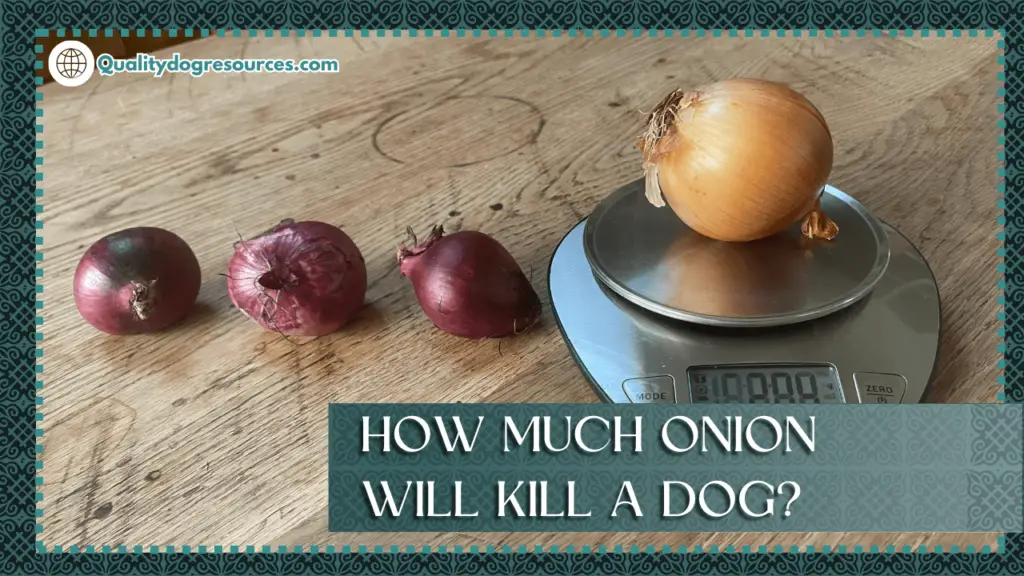
The amount of onion that it takes to kill a dog will depend on the dog’s weight. Bigger dogs have a higher tolerance of onions than smaller dogs.
So if a Chihuahua, Labrador and Great Dane were all to eat a few slices of onion then the Chihuahua would be in much greater danger than the Labrador or the Great Dane.
There are three formulas to use in order to help you calculate if your dog has eaten enough onion to poison itself. Just use the formula that is easiest for you.
.5% weight
The most popular formula is that a dog can safely eat up to .5% (half a percent) of their body weight in onions before they are in danger of being poisoned.
This formula can be used with either kilograms or pounds and it’s easy to produce a calculation for any weight of dog
Let’s use my dogs, who weigh 30 kilograms each (66 lbs.)
0.5% of thirty kilograms is 165g. My 30 kg dog can safely eat up to 165g of onions before the onions will start to poison her.
.5% of sixty six pounds is 5.82 ounces. My 66 lb dog can safely eat 5.82 ounces of onions before the onions will start to poison her.
100g/ 20 kg
The next most popular formula that dog owners use in order to calculate if their dog has eaten too much onion is the 100g/ 20 kilogram rule.
This formula was created because a huge number of our pet dogs weigh in or around 20 kilograms.
However, this formula is more restrictive than the formula above because it uses kilograms as the unit for the weight and so if you don’t know the weight of your dog in kilograms, the calculation will be a lot tougher.
This formula is also limited because unless your dog weighs 20 kilograms or a multiple of that weight (10 kg, 30 kg, 40 kg, 50kg, 60 kg) then the calculation will take longer.
With my 30 kilogram dogs, the calculation is that my dogs should eat no more than 150g of onion.
15-30g/ kg
The 15- 30 g of onion per kilogram of a dog’s weight is great for small dog breeds- dogs that weigh less than 10 kg. However, the 15- 30 g weight range is too vague. And it suggests that a dog can eat far more onions than either of the two calculations above.
This calculation (using the 15 g/ kg amount) suggests that a 30 kilogram can eat up to 450g of onion before a dog will be in danger of becoming dangerously poisoned.
What are the signs of onion toxicity in dogs?
There are several signs and symptoms of onion toxicity in dogs- unfortunately these signs tend to appear a few days after the incident. And they are:
weakness,
lethargy
exercise intolerance (as a dog begins to feel the effects of not having enough oxygen) together with
rapid breathing (tachypnea) and
rapid heart rate (tachycardia) as a dog struggles to provide their body with more oxygen.
How long does it take for onions to poison a dog?
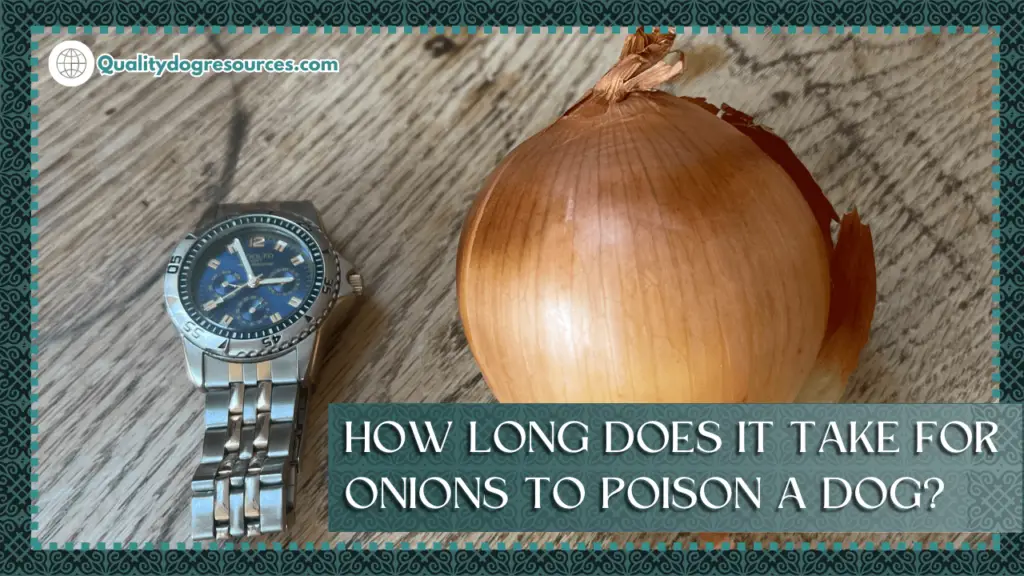
The length of time that it takes for a dog to be poisoned by onions will vary from dog to dog. As we have already said, the size of the dog and the amount of onion that they have eaten are two important factors.
Within 24 hours, the red blood cells within a dog’s body will begin to show signs of damage and the damage will be at its most destructive 72 hours after a dog ate onions. The damage to the red blood cells can be confirmed via a blood test- which is something that your local vet would do.
Four ways that vets treat dogs with onion poisoning
There are four methods that a vet will use to treat a dog with onion poisoning. They are:
- Blood test
- Induced vomiting
- Activated charcoal
- Fluid therapy
What method a veterinarian will use depends upon how poorly the dog is, how long ago they ate onion and how much onion they ate.
Blood test
In the previous section, I mentioned that a vet might use a blood test to treat a dog with onion poisoning. The test is called a complete blood count (CBC.) As well as looking at the number of white blood cells and the number of red blood cells, the test will show if there has been any damage to the red blood cells- and these irregularly shaped red blood cells are called Heinz bodies. The presence of Heinz bodies confirm that the dog is anaemic (and has eaten a large amount of onion) and the number of Heinz bodies indicate how anaemic the dog is.
Induced vomiting
If a dog is taken to the vets very soon after it has eaten the onion (within a couple of hours), a vet might try to induce vomiting so that as much of the onion as possible is gotten rid of before it has time to start being digested.
Activated charcoal
If the incident occurred longer than two hours ago then a vet might use activated charcoal. Activated charcoal is a fine black powder. It’s called “activated” because it has been treated with oxygen in order to make it porous. Activated charcoal is given to dogs orally- the dosage will depend on the size of the dog and the amount of toxin that they have eaten. Once the charcoal is ingested it binds or absorbs the toxins in a dog’s gastrointestinal tract, which stops the toxins from being absorbed.
Fluid therapy
The last method or approach that a vet might use with a dog with onion poisoning is to have fluid delivered to them intravenously. Fluid therapy is when a dog is provided with extra fluids in order to make up for any fluids they might have lost. Extra fluids are most commonly administered to a dog intravenously- through a vein. The two reasons for treating a dog with onion poisoning with fluids would be to treat dehydration after episodes of vomiting or diarrhoea.
Can dogs with onion poisoning be treated at home?
Dogs with onioning poisoning can’t be treated at home. Some veterinarians might guide an owner step by step through how to induce their dog to vomit over the phone but that would be in exceptional circumstances. If your dog has onion toxicity the normal procedure would be to take them to the vet as soon as possible.
What types of onions are toxic to dogs?
(Image) collage raw onions, cooked onions
Can a dog eat raw onions?
Dogs can’t eat raw onions because they contain the chemical n- propyl disulphide.
Can dogs eat cooked onions?
Dogs can’t eat cooked onions. Cooking doesn’t destroy the chemical n-propyl disulphide
Can dogs eat green or spring onions?
Dogs can’t eat green or spring onions as they contain the chemical n-propyl disulphide
Can dogs eat red or purple onions
Dogs can’t eat red or purple onions as these onions still contain the chemical n-propyl disulphide
Can dogs eat onion powder?
Dogs can’t eat onion powder. Onion powders tend to be a more concentrated form of onion than fresh onions and so the amount of the chemical n-propyl disulphide that it contains is higher than the amount in a fresh onion.
Can dogs eat yellow onions?
Dogs can’t eat yellow onions as these onions still contain the chemical n-propyl disulphide
Can dogs eat pickled onions?
Dogs can’t eat pickled onions as these onions still contain the chemical n-propyl disulphide. Pickled onions are made using white onions that still contain the chemical n-propyl disulphide.
Can dogs eat the other vegetables that are members of the onion family?
(Image) onion, garlic, leeks, chives, shallots
Dogs cannot eat other members of the onion family. The onion family of plants is called Allium and the family includes onion, garlic, leeks, chives and shallots. All of these vegetables contain the compound n-propyl disulphide which is why they can be toxic for dogs.


